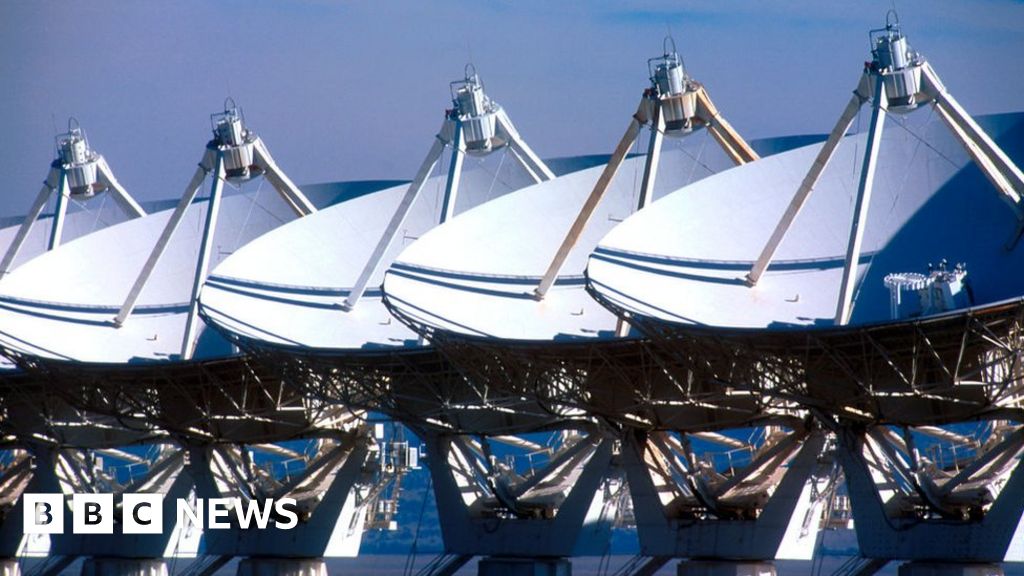
- Written by Emma Woollacott
- Business reporter
Image source, Getty Images
The Very Large Array facility in New Mexico is searching for signs of alien life
Bill Diamond says: There are between 10 and 50 billion potentially habitable worlds in our galaxy. This makes his task somewhat difficult.
Mr. Diamond is the CEO of the US-based SETI Research Institute. The letters “Seti” are an abbreviation for Search for Extraterrestrial Intelligence.
“SETI, as an endeavor, is looking for science and technology outside the solar system as evidence of life and intelligence, and that's very much a needle in a haystack problem,” he says.
“We're looking for something that is potentially very rare, and that can be very difficult to find and extract from the background phenomena you're observing at the same time.”
But new tools are helping the search. The ability of artificial intelligence (AI) to handle massive data sets – and detect anomalies – is transforming the search for alien intelligence.
One such project involves a partnership between the SETI Institute and the US National Radio Astronomy Observatory in New Mexico. This federal facility uses radio frequencies to study celestial bodies, such as planets, stars and asteroids.
SETI is building a parallel AI software system for the observatory's core facility, which is… Very large array. Built between 1973 and 1981, the VLA consists of 28 large antenna dishes with a diameter of 25 meters distributed over a desert plain. Imagine the satellite dishes you find in people's homes, on a massive scale.
When operational, the AI will be able to process every bit of data captured – 2 terabytes (TB) per second. To put that in context, modern laptops typically have around 1TB of total storage space.
Image source, Bill Diamond
Mr. Diamond says the use of AI is already invaluable
Mr Diamond says the increasing use of artificial intelligence is already proving “indispensable” as his institute continues the search for alien life.
He points out that artificial intelligence makes it possible to search for new types of radio signals from exotic sources. He explains that SETI has traditionally looked for narrow-band signals similar to those used by humans.
“But there was always the question ‘what if there was advanced space-based technology that used broadband [radio]”If that's the case, our traditional methods won't work, and it will just look like a bunch of noise on the screen.”
However, Mr Diamond says AI's ability to handle huge amounts of data means it could be possible to take millions of “snapshots” of this snowy sonic picture over time, and start looking for patterns. “It's a way to add something new to research.”
Another project that Seti is collaborating with is Breakthrough listening. The scheme, backed by more than £100 million of private sector funding, scans 1 million stars and 100 galaxies, across a wide range of radio and optical bands, for evidence of technological life.
One of the project members, University of Toronto student Peter Ma, recently developed a new artificial intelligence system designed to examine telescope data, distinguish between potentially real signals from extraterrestrials, and interference.
His team did this by simulating both types of noise, then training their AI to distinguish between the two.
Ma says that a space signal, for example, “appears only when we point our telescopes at it… and disappears when we point it away.”
The project has already identified eight potential space signals that have not been detected by conventional analysis. However, Mr. Ma believes that since the observations have not yet been repeated, they are likely to be false positives.
Artificial intelligence is also being used to try to detect signs of life of a more modest nature, closer to home.
Last year, NASA's Perseverance spacecraft began collecting samples from Jezero Crater on Mars, which, if all goes well, will be returned to Earth within several years.
Image source, Getty Images
NASA's Perseverance spacecraft is collecting rock samples from the surface of Mars
Indeed, scientists believe the rover's Sherlock instrument has detected organic compounds that glow under ultraviolet light.
However, organic compounds can be created through non-biological processes, which means it is not yet possible to determine whether they are derived from past life on the planet.
But all that could change thanks to new research by the Carnegie Institution for Science, which uses artificial intelligence to analyze rock samples for signs of current or past life.
The team found that the AI is able to distinguish between formerly living and non-living materials, with approximately 90% accuracy.
“This is a very new approach to searching for molecular biosignatures,” says co-principal investigator Dr. Robert Hazen.
“We use machine learning to look at all the huge amounts of data through an analytical method that produces half a million data points per sample. So we are looking for subtle patterns in the molecular distributions.”
The first plans are to use the system to analyze ancient samples from Earth, as well as some Martian samples in the form of meteorites. But, Mr. Hazen says, “We could, for example, fly an instrument through the plumes of Enceladus [one of Saturn’s moons]”Or landing a carefully designed instrument on the surface of Mars.”
It's early days, and any promising results generated by AI need to be validated by other observations, or by physics-based models, before they can be announced from the rooftops. But as more and more data is collected and analysed, the chances of discovering alien life – if it exists – are increasing all the time.
Meanwhile, Diamond says, “progress is measured by the amount of effort, not yet the results.”

“Web maven. Infuriatingly humble beer geek. Bacon fanatic. Typical creator. Music expert.”





More Stories
Scientists confirm that monkeys do not have time to write Shakespeare: ScienceAlert
SpaceX launches 23 Starlink satellites from Florida (video and photos)
A new 3D map reveals strange, glowing filaments surrounding the supernova